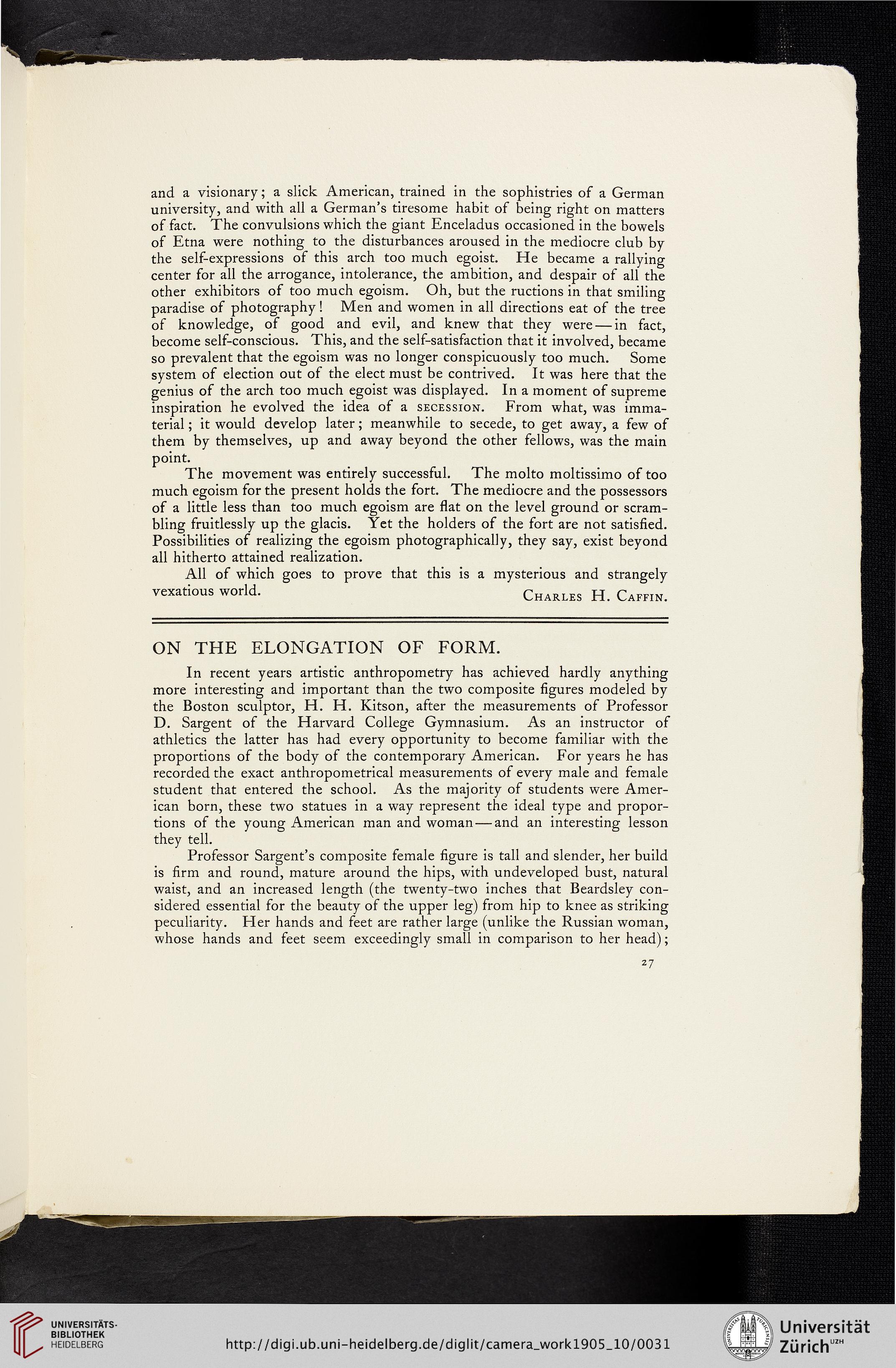Für diese Seite ist auch eine manuell angefertigte Transkription bzw. Edition verfügbar. Bitte wechseln Sie dafür zum Reiter "Transkription" oder "Edition".
and a visionary; a slick American, trained in the sophistries of a German
university, and with all a German's tiresome habit of being right on matters
of fact. The convulsions which the giant Enceladus occasioned in the bowels
of Etna were nothing to the disturbances aroused in the mediocre club by
the self-expressions of this arch too much egoist. He became a rallying
center for all the arrogance, intolerance, the ambition, and despair of all the
other exhibitors of too much egoism. Oh, but the ructions in that smiling
paradise of photography! Men and women in all directions eat of the tree
of knowledge, of good and evil, and knew that they were — in fact,
become self-conscious. This, and the self-satisfaction that it involved, became
so prevalent that the egoism was no longer conspicuously too much. Some
system of election out of the elect must be contrived. It was here that the
genius of the arch too much egoist was displayed. In a moment of supreme
inspiration he evolved the idea of a secession. From what, was imma-
terial; it would develop later; meanwhile to secede, to get away, a few of
them by themselves, up and away beyond the other fellows, was the main
point.
The movement was entirely successful. The molto moltissimo of too
much egoism for the present holds the fort. The mediocre and the possessors
of a little less than too much egoism are flat on the level ground or scram-
bling fruitlessly up the glacis. Yet the holders of the fort are not satisfied.
Possibilities of realizing the egoism photographically, they say, exist beyond
all hitherto attained realization.
All of which goes to prove that this is a mysterious and strangely
vexatious world. Charles H. Caffin.
ON THE ELONGATION OF FORM.
In recent years artistic anthropometry has achieved hardly anything
more interesting and important than the two composite figures modeled by
the Boston sculptor, H. H. Kitson, after the measurements of Professor
D. Sargent of the Harvard College Gymnasium. As an instructor of
athletics the latter has had every opportunity to become familiar with the
proportions of the body of the contemporary American. For years he has
recorded the exact anthropometrical measurements of every male and female
student that entered the school. As the majority of students were Amer-
ican born, these two statues in a way represent the ideal type and propor-
tions of the young American man and woman — and an interesting lesson
they tell.
Professor Sargent’s composite female figure is tall and slender, her build
is firm and round, mature around the hips, with undeveloped bust, natural
waist, and an increased length (the twenty-two inches that Beardsley con-
sidered essential for the beauty of the upper leg) from hip to knee as striking
peculiarity. Her hands and feet are rather large (unlike the Russian woman,
whose hands and feet seem exceedingly small in comparison to her head);
university, and with all a German's tiresome habit of being right on matters
of fact. The convulsions which the giant Enceladus occasioned in the bowels
of Etna were nothing to the disturbances aroused in the mediocre club by
the self-expressions of this arch too much egoist. He became a rallying
center for all the arrogance, intolerance, the ambition, and despair of all the
other exhibitors of too much egoism. Oh, but the ructions in that smiling
paradise of photography! Men and women in all directions eat of the tree
of knowledge, of good and evil, and knew that they were — in fact,
become self-conscious. This, and the self-satisfaction that it involved, became
so prevalent that the egoism was no longer conspicuously too much. Some
system of election out of the elect must be contrived. It was here that the
genius of the arch too much egoist was displayed. In a moment of supreme
inspiration he evolved the idea of a secession. From what, was imma-
terial; it would develop later; meanwhile to secede, to get away, a few of
them by themselves, up and away beyond the other fellows, was the main
point.
The movement was entirely successful. The molto moltissimo of too
much egoism for the present holds the fort. The mediocre and the possessors
of a little less than too much egoism are flat on the level ground or scram-
bling fruitlessly up the glacis. Yet the holders of the fort are not satisfied.
Possibilities of realizing the egoism photographically, they say, exist beyond
all hitherto attained realization.
All of which goes to prove that this is a mysterious and strangely
vexatious world. Charles H. Caffin.
ON THE ELONGATION OF FORM.
In recent years artistic anthropometry has achieved hardly anything
more interesting and important than the two composite figures modeled by
the Boston sculptor, H. H. Kitson, after the measurements of Professor
D. Sargent of the Harvard College Gymnasium. As an instructor of
athletics the latter has had every opportunity to become familiar with the
proportions of the body of the contemporary American. For years he has
recorded the exact anthropometrical measurements of every male and female
student that entered the school. As the majority of students were Amer-
ican born, these two statues in a way represent the ideal type and propor-
tions of the young American man and woman — and an interesting lesson
they tell.
Professor Sargent’s composite female figure is tall and slender, her build
is firm and round, mature around the hips, with undeveloped bust, natural
waist, and an increased length (the twenty-two inches that Beardsley con-
sidered essential for the beauty of the upper leg) from hip to knee as striking
peculiarity. Her hands and feet are rather large (unlike the Russian woman,
whose hands and feet seem exceedingly small in comparison to her head);


